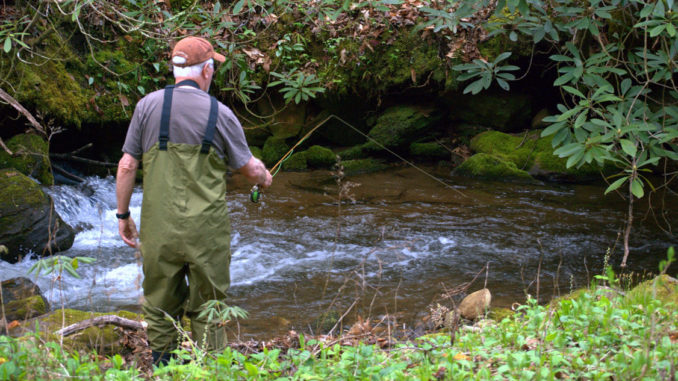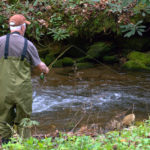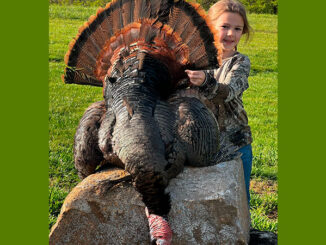
Spring trout are in more streams than you know
The early Cherokee marked the beginning of the trout fishing season when trout lilies began blooming along mountain streams in early April. One of the earliest blooming spring wildflowers, the trout lily, with its yellow blooms, is aptly named because of the mottled, flat leaves that resemble the markings on the bodies of brook trout.
Likely more to do with coincidence than by design, North Carolina’s hatchery supported streams reopen in April when trout lilies are in full bloom.
Spring trout fishing hits its peak in early April with a constant barrage of hatches that continue through May, sometimes into early June, depending on weather: Quill Gordons, Blue Quills, Caddis, Stones, Blue Duns, Hendricksons and Blue-Wing Olives, to name a few.
Too often, trout fishers fall into a comfortable pattern of fishing the same streams over and over because they know where the fish are likely to be. Maybe spring is the time to try a new stream or two, and there are hundreds of streams in western North Carolina, Upstate South Carolina, the Great Smoky Mountains National Park, along the Blue Ridge Parkway and on the Cherokee reservation — more streams than you could fish in a lifetime.
Wild-trout streams are open to fishing year-round in the Great Smoky Mountains Park, in western North Carolina and Upstate South Carolina. With a few exceptions, fishing is limited to artificial lures with a single hook. Creel limits are four per day in North Carolina, five per day in South Carolina, and five per day in the GSMNP. Cherokee streams have a 10-fish daily creel limit.
Either a North Carolina or Tennessee fishing license is required for fishing streams in the Great Smoky Mountains National Park, but they are the only licenses or permits required.
Additionally, North Carolina has numerous small mountain streams that aren’t designated as public mountain trout waters. These streams have no size limits, no bait or lure restrictions and are open to fishing year-round. The daily creel limit is seven trout per day.
Although these streams are not stocked, they are closed to catch-and-keep fishing during March, the same as hatchery-supported waters. Only a state fishing license is needed to fish undesignated waters. The majority of these streams are small and, as a result, are usually bypassed by most trout fishers. They often can provide some surprisingly good fishing.
In South Carolina, most streams have a split season. Fishing is limited to catch-and-release from Nov. 1 through May 14. On May 15, streams, with a few exceptions, open to catch-and-keep fishing, most with no bait or lure restrictions.
One major exception is Lake Jocassee, where the creel limit is three trout per day. From Oct. 1 through May 30, the size limit is 15 inches, and only one can be 20 inches are longer. Between June 1 and Sept. 30, three trout of any size may be kept. The use of corn, cheese, fish eggs or imitations is prohibited.
In South Carolina, the majority of trout streams are in Oconee, Pickens and Greenville counties. The tailwaters of Lake Hartwell and Lake Murray also are open to trout fishing.
The S.C. Department of Natural Resources has an excellent online trout-fishing guide (www.dnr.sc,gov/fish/pdf/TroutBook.pdf) with maps, stream listings and other useful information. Stream regulations are also available online at (www.dnr.sc.gov/regulations).
For North Carolina, trout-fishing information, maps, stocking schedules and regulations are available at (www.ncwildlife.org).
The Cherokee Indian Reservation has more than 30 miles streams open to public fishing on the Oconaluftee River, Raven Fork, Bunches Creek and Soco Creek, plus three ponds in the Big Cove area. A 2-mile section of the Oconaluftee River in the Big Cove area is designated as trophy trout waters and limited to catch-and-release fly fishing. Only a tribal permit ($10 per day) is required to fish Enterprise Waters, but a separate permit is required for the trophy waters.
The Blue Ridge Parkway’s 100 miles of streams offer both wild and hatchery-supported trout fishing, the latter managed by the N.C. Wildlife Resources Commission. Only a state fishing license is required to fish parkway streams.
Stone Mountain State Park in Alleghany County has two streams designated as “just for fun” fishing streams: Bullhead and Rich Mountain. Fishers buy a permit that gives them exclusive access to designated portions of the streams. The majority of the fish in Bullhead are trophy size, some more than 30 inches.
Most mountain streams are in good condition with normal flows, thanks to the abundant and much need winter rainfall, so spring trout fishing should be exceptional and a good time to explore the numerous trout waters in North and South Carolina.







Be the first to comment